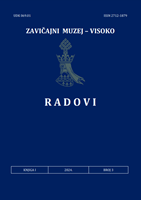Arduba – “Visoki grad”?
Arduba – “the City of Visoki”?
Author(s): Salmedin MesihovićSubject(s): Archaeology, Social history, Ancient World
Published by: JU Zavičajni muzej – Visoko
Keywords: Arduba; Visoko; Great Illyrian Uprising; Germanicus; Cassius Dio;
Summary/Abstract: In his narrative about the Great Illyrian Uprising, Roman historian and senator Cassius Dio, describing the last days of the organized resistance of the insurgents, also described the destruction of a settlement named Arduba (Ἄρδουβα). With the exception of this mention by Cassius Dio, the name Arduba is no longer found in the available original material. Due to Dio’s dramatic and cathartic description of its destruction, Arduba has become one of the most famous ancient settlements in modern and postmodern historiography and archaeology of the Illyroslavic areas, but also the most mysterious in the research process. What happened to Arduba and its inhabitants in the late summer of 9 AD became the main symbolic determinant for the Great Illyrian Uprising, as well as a symbol of the tragic history that this area has experienced from generation to generation for more than two millennia. Based on the geographical and other coordinates found in Dio’s description, Arduba has been proposed in various locations within the Dinaric area. W. Tomaschek first suggested the site of Vranduk, north of Zenica, as the location of Arduba, and this assumption has gained acceptance in both scientific literature and the general public. Nonetheless, archaeological excavations at Vranduk did not yield any finds from prehistoric, protohistoric, or classical civilizations. O. Hirschfeld identified Arduba with the locality of Anderba/Sanderva, but this location is also deemed unsuitable. Tomaschek later suggested in the PWRE edition that Arduba was likely in the territory of the nation of the Daesitiates and that several places in Bosnia, such as Jajce, fit its description. Ferdo Šišić suggested Vranduk as a likely location but also considered it possible that Arduba was situated somewhere along the Upper Drina, around Goražde, Foča, or Višegrad. Enver Imamović reaffirmed the thesis about Vranduk as a possible location for Arduba. Ivo Bojanovski and Veljko Paškvalin placed Arduba within the territory of the nation of Daelmates, while Darko Periša proposed the area of Burnum along the Krka River. Although each of the mentioned proposed locations meets some of the coordinates for the location of Arduba, they still do not give a complete picture and ultimately raise more questions and doubts than answers. Perhaps the location of Arduba can also be sought based on the etymology of its name. The etymology of Arduba can be connected to Proto-Indo-European *h₃erdʰ, meaning “high,” “to be upright,” “to grow,” or “to increase.” If Arduba is etymologically related to these meanings, it is possible that its name denoted “High,” “Elevated,” “High Town,” “High Settlement,” “High Fort,” etc. (Visoko, Visoki, Uzdignuto, Na visini, Visoki Grad, Visoko Naselje, Visoka utvrda, etc.). It is interesting, however, that there really is an archeological site that could possibly satisfy the previously mentioned criteria for the tentative location of Arduba and whose name bears etymological significance in relation to the presented etymology. This site is the town of Visoki on the Visočica hill above Visoko or Podvisoki itself. Visočica (with the Grad plateau, elevation 767) rises above the course of the Fojnica River just before its confluence with the Bosna River, while Podvisoki/Visoki is located right next to the confluence zone of these two rivers.
Journal: Radovi Zavičajnog muzeja - Visoko
- Issue Year: 1/2024
- Issue No: 3
- Page Range: 9-31
- Page Count: 23
- Language: Bosnian

